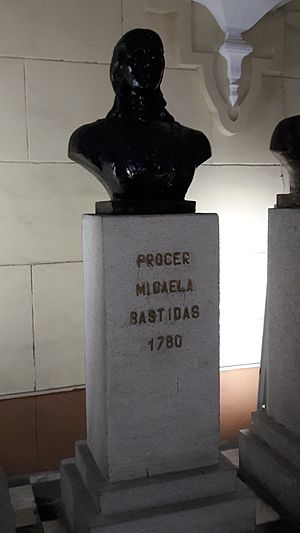Micaela Bastidas facts for kids
Micaela Bastidas Puyucahua (born in Tamburco, 1744; died in Cusco, May 18, 1781) was a brave indigenous leader. She fought against Spanish rule in South America. Micaela is seen as a martyr for Peruvian independence.
With her husband, Túpac Amaru II, she led a big rebellion. When the revolt failed, she was executed by the Spanish. She was a full partner in her husband's work even before the rebellion. Many people describe her as a very skilled leader of the rebellion. She played a key role in organizing the rebel army in Cusco in 1780 and 1781.
Contents
Micaela Bastidas's Early Life

Micaela Bastidas was born in Pampamarca, Peru, in 1744. Her parents were Josefa Puyucahua Sisa and Manuel Bastidas. Not much is known about her father. Some documents suggest she was of mixed race, with both African and indigenous heritage. This was called "Zamba" during that time.
Micaela spoke Quechua better than Spanish. She was a devoted Catholic but did not have much formal schooling. She was described as a "beautiful Indian girl."
Marriage to Túpac Amaru II
On May 25, 1760, Micaela married José Gabriel Condorcanqui. He later became known as Túpac Amaru II. He was a descendant of the Inca leader Túpac Amaru I. The Spanish had executed Túpac Amaru I in 1572.
In 1764, José Gabriel became the cacique or kuraka (a local chief) of Pampamarca, Tungasuca, and Surimana. This title was passed down through his family. He and Micaela lived in Tinta, a region near Cusco. They had three sons: Hipólito (born 1761), Mariano (born 1762), and Fernando (born 1768).
José Gabriel had a good education from the Jesuits in Lima and Cusco. He spoke Spanish, Quechua, and some Latin. He owned a lot of land and was a successful trader. He had many mules to carry goods. This helped him meet many people and understand their problems.
He saw how the Spanish rules hurt his people. He tried to get the Spanish authorities to free indigenous people from forced labor. But his requests were often ignored. This led him to develop ideas about freedom for indigenous people, slaves, and mixed-race people. He wanted Peru to be independent from Spain.
Micaela and José Gabriel had a strong and loving partnership. Letters they wrote to each other show their affection and concern for each other's safety during the rebellion.
Leading the Rebellion
In 1780, after trying to talk with the Spanish, José Gabriel Condorcanqui started a movement against Spanish rule. He took the name Túpac Amaru II. This was to honor his ancestor, the last Inca ruler. Many people supported him, including other chiefs, Creoles (people of Spanish descent born in the Americas), indigenous people, and mestizos (mixed-race people).
On November 4, 1780, Túpac Amaru II declared freedom. This began the rebellion of Túpac Amaru II. They captured and executed the local Spanish commander, Antonio de Arriaga. The rebels set up their main base in Tungasuca.
Micaela's Role in the Fight
Indigenous people were not allowed to have firearms. So, getting weapons was a big challenge. Micaela was in charge of supplying the rebel troops. This meant getting and giving out money, food, clothes, and weapons. She also issued special passes for people to travel safely through rebel areas.
Micaela managed the rebel army's support system. She was very organized and skilled. She put in place security measures and fought against spies. She also created a fast communication system. She organized a chasquis service, using messengers on horseback to quickly send information.
Many Andean fighters, both Quechua and Aymara, worked with Micaela. They planned strategies and supported the troops. Micaela wanted to free her people from Spanish exploitation. She also wanted to bring back the important role of indigenous women in society and politics. The Spanish colonial system had tried to take this away.
Other women leaders were also part of the movement. These included Cecilia Túpac Amaru and Tomasa Tito Condemayta. Many women, along with their children and husbands, fought in the battles. Micaela was very energetic and encouraged Túpac Amaru from the battlefield. After the victory at Sangarará, she became an acting leader of the rebellion.
On November 18, 1780, the rebel army won the Battle of Sangarará. Túpac Amaru sent a message to all Peruvians. He asked Creoles to join the indigenous cause. He said, "Creoles, mestizos, zambos, and Indians, we are all compatriots, as we were born in these lands and are of the same origin."
By March 1781, Túpac Amaru's army had about seven thousand men and women. They were ready to fight for freedom. Túpac Amaru II was even proclaimed Emperor of America. Records from that time show Micaela as the main strategist. She handled political, military, and administrative tasks. She was also the main advisor to the leader. Her strong beliefs and clear thinking made her a vital part of the rebellion.
In 1976, the Peruvian government passed a law (N° 21705). This law recognized the great historical importance of the 200th anniversary of the rebellion led by Túpac Amaru and Micaela Bastidas.
Execution and Legacy
On May 18, 1781, Micaela Bastidas and her son Hipólito were taken to the Plaza de Armas in Cuzco. They were executed in front of Túpac Amaru II, who was then also executed. Micaela was 36 years old.
This event inspired many people in South America. It helped fuel the later wars for independence from Spain.
See also
 In Spanish: Micaela Bastidas para niños
In Spanish: Micaela Bastidas para niños



